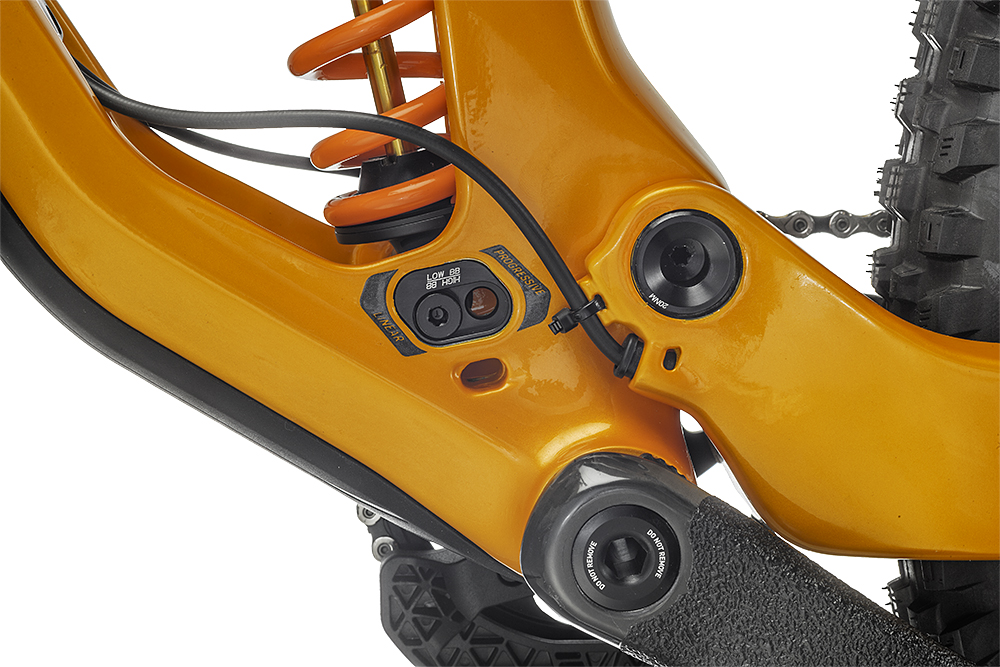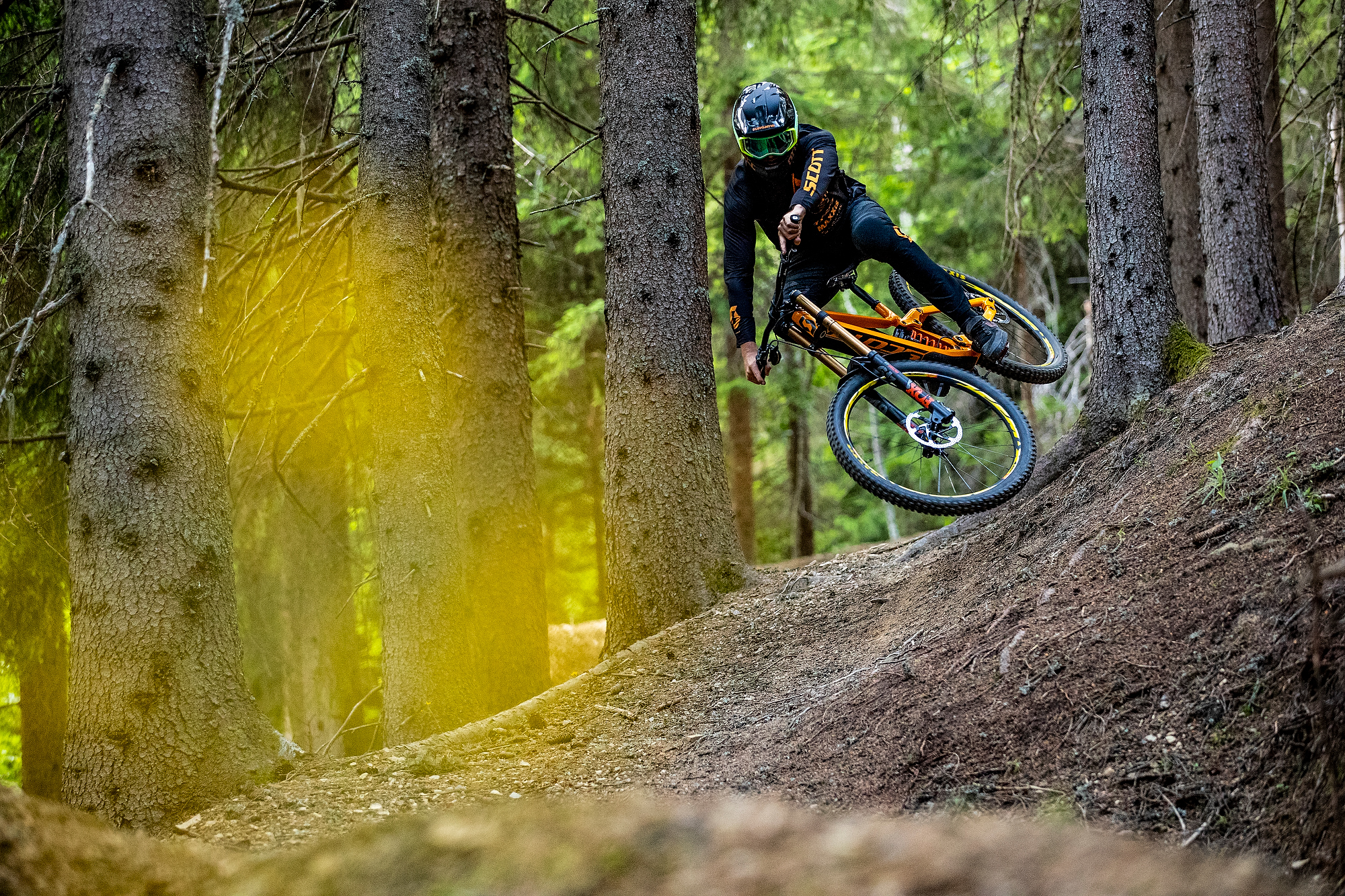After a long and very public development process the new Scott Gambler has been unleashed, and it's lighter and faster than ever before.
Scott Gambler 900 Tuned first ride review
After a long and very public development process the new Scott Gambler has been unleashed, and it’s lighter and faster than ever before.
>>> Which Scott mountain bike is right for you?
Scott Gambler need to know
- Long awaited refresh for Scott’s World Cup downhill bike
- Carbon frame runs either 29in or 27.5in wheels
- Fully adjustable geometry
- Big weight reduction over the old bike
- Frame kit for €4,199
If you follow the UCI World Cup Downhill, you’ll know that – much like the new Specialized Demo launched just two days ago – Scott’s Gambler has been seen in multiple prototype stages over the past couple of years. Finally it’s ready for public consumption, although by public, I mean anyone with an €8,000 budget and the skills and terrain to make such a capable bike earn its keep.
That the old bike was long in the tooth is in no doubt – it hasn’t really changed in seven years – so what does the new bike bring to the table?
Perhaps the most significant improvement is in the weight. The old Gambler was a hefty unit – the last one I rode back in 2013 weighed an astonishing 17.72kg, while the new model comes in at 15.1kg. That’s over 2.5kg lighter, despite moving to bigger and heavier 29in wheels.

The new Gambler is lighter and sleeker than the old model. It also gets a new chainguide mount instead of ISCG, visible here.
Where do the savings come from?
With a claimed frame weight (without shock) of 2,650g the new frame is over 600g lighter than the old version. Smaller forgings, thinner tubing, a simpler frame construction and the move to carbon have all hacked away at the lard.
The old Gambler was really adjustable, has that been carried across to the new version?
Yes, and then some. Just like the old bike, offset headset cups give +/-1° head angle adjust, there’s an axle flip-chip to change the chainstay length from 435mm to 450mm and a new BB height/linkage progression chip that lets you pay with the ride height and the suspension feel. Couple that with fork crown adjustment, wheel size changes (you can run 29in or 27.5in front and rear, or mix it up mullet-style) and spring and damper settings and it’s enough to make your head spin.

Two different BB heights and two shock positions make this one of the most adjustable bikes in the paddock
Talk me through a few different set-ups…
Ok, here goes. Say you’re riding steep tracks with little or no pedalling, you might run the -1° headset cups to rake out the front end, then put the back wheel in the longer chainstay setting to keep you balanced between the front wheels, and the low BB setting because pedal strikes aren’t an issue. Conversely, if you’re riding bike parks, you might keep the BB setting, but run the zero offset (or +1°) cups and the short chainstay to keep it agile and playful. For taller riders, the longer chainstay could also help with weight balance combined with a long front centre, and vice versa.
What about the shock progression?
Included in the BB chip are two different (fore/aft) positions for the lower shock mount. Forward is less progressive (for example rough, natural tracks or air shocks) and rearward is more progressive (for example big jumps and coil shocks).
Syncros Hixon IC DH bar/stem brings sci-fi to DH
This is Scott – there must be some other funky elements to the new Gambler?
You guessed it! Up front there’s a new Syncros one-piece carbon bar/direct mount stem. It’s called the Hixon IC DH (€349) and is said to be incredibly strong for its weight. Fortunately it doesn’t have a kooky shape to it, even if it looks a bit distracting. There’s also a new integrated Syncros DH fender (€19.99) that mounts on the Fox 49 fork. The good news is it offers much more comprehensive coverage than its trail-orientated relative, and although we haven’t had a chance to put it to the test yet, it looks like it should actually do a decent job. There’s also a Syncros Comox saddle (€99.90) with truncated rear to give more clearance to the big 29in wheel at full travel.
Finally, Scott has ditched the ISCG standard and gone out on a limb with a new twin-bolt chainguide fixture. As it did when frames started eliminating the front mech, it says this radically frees up design and engineering to improve the frame strength, stiffness, packaging and weight. In a nutshell, there’s now a wider main pivot and better chainstay clearance.
So how does it ride?
Hands up – it’s been three years since I last rode a downhill bike, so I can’t claim to be the world’s leading expert on them. Equally the test bike I was sent didn’t have the correct spring rate so I was only running around 20 per cent sag, and with nothing DH-worthy near my house, BikePark Wales was the closest option with a running uplift. And to be honest, it’s not even steep enough to challenge a modern DH bike.
So I spent the day riding it on the newly revamped Enter the Dragon and Pork Belly tracks, scaring myself silly with the biggest jumps I could find.
That was, however, after I’d spent an hour getting it roughly set up in the car park. Yes, getting a DH bike tuned is a mission – great if you’re a racer, somewhat annoying when you just want to get the laps in.
It’s fair to say DH bikes can often feel unwieldy and cumbersome to begin with, and take some recalibration until your inputs and timing are in tune with their mass, their physical size and their thirst for speed.
Not so with the new Gambler. Its low weight definitely made it a more friendly, approachable rig than I has anticipated, and the comprehensive adjustability meant I could optimise it to the flatter, bike park trails and compensate for the lack of sag.
With the bars dropped 10mm to put more weight on the front tyre, the BB in the low setting and the short chainstays, it actually felt relatively rewarding and agile, with ridiculous levels of performance left in reserve – I just couldn’t ride it hard enough to really push its limits.
Even in the less progressive setting, the rear suspension felt fluid and supportive, and when I got near full travel it just shrugged its shoulder as if to say ‘is that all you’ve got?’ But I did notice a slight disparity in feel front to back – the air-sprung Fox 49 fork giving a tighter, less friendly response and more harshness than the welcoming, pitter-patter plushness of the coil-sprung DHX2 shock.
This was my first time on a 29er DH bike and, at 5ft10in, I was surprised at how easy it was to get tangled up in the rear wheel on steep drops. It’s a problem I’ve only encountered once or twice on 29er enduro bikes, but it happened to me twice in one day on the Gambler. And one of those was pretty bad. Going forward, I’d probably run it as a mullet bike to prevent this happening.
So the new Gambler feels absolutely rock-solid, but still relatively chuckable thanks to its light weight, and the adjustability means it’ll be adaptable to a huge variety or tracks and preferences. If you’re a privateer racer looking for a new weapon to thread between the tape, your short list just got a bit longer (although you’ll have to wait until December yo get your hands on one).























